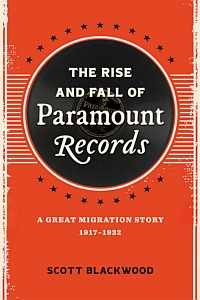One of the greatest but least researched American record labels, Paramount from Grafton, Wisconsin, is the subject of Scott Blackwood’s title at hand, that introduces itself as a blend of solid historical research, good artist presentation and a bit of fiction.
 Maybe it has to do with Blackwoods’s first calling as a writer of novels, that adds this special flavor. Once readers get used to that, Paramount’s brief but highly influential tale as a seller of shellacs that chronicles the early years of Black Music and covered the heydays of early jazz, piano blues and commercial gospel recording picks up speed easily.
Maybe it has to do with Blackwoods’s first calling as a writer of novels, that adds this special flavor. Once readers get used to that, Paramount’s brief but highly influential tale as a seller of shellacs that chronicles the early years of Black Music and covered the heydays of early jazz, piano blues and commercial gospel recording picks up speed easily.
Paramount Records originally went into business building phonograph cabinets for the Edison Company in 1916, as a subsidiary of the Wisconsin Chair Company. Such cabinets then were polished, huge and usually heavy pieces of furniture that housed the playback technology, a big sound horn and would provide space to store the shellacs, the high-end audio preservation format of the day. The musical styles, however, were of no importance to Paramount’s manufacturers, as those discs were regarded as little more than novelty toys that would soon fade from anybody’s memory as there would be new discs every other day. The cabinets were Paramount’s original line of business, which may explain the many grave future mistakes the company would make from its start in 1917.
With their own recording studios in Port Washington, Wisconsin, although labeled “New York Laboratories” in their ads, they would enter music sales while nobody on the company’s executive level had any experience in the music business. Later, they would also record in studios in Chicago. They brought their own talent and tried to compete with an early recording industry that years before already had made contracts with the popular artists from pop and vaudeville. Lacking those big names, Paramount would record and produce unknown and rather not first-rate talent. Unlike other labels that sent talent scouts to the remote parts of the US, basically the South making field recordings, Paramount executives never understood such investments and instead continued without new musical discoveries, resulting almost in insolvency.
Luckily, soon the blues craze was on and race records, black artists being recorded for a black audience, became a substantial line of income for some labels, including Paramount. In 1923, they had hired J. Mayo Williams, WWI veteran, college-educated, popular football player and bootlegger on Chicago’s South side as recording manager and “impresario.”
A year later, they bought Black Swan Records. Williams was the first African-American executive hired by a white recording company. He set up Paramount offices in Chicago instead of Grafton, would save the company from bankruptcy and during the last ten years of its existence would turn it into the important label it is still remembered today. He produced around 700 recordings for the label, mostly black artists for the booming race records market, although he was not a big fan of the style, but preferred opera instead. As both audiences and artists were part of the massive relocation from rural Southern communities to industrial regions of the North, the story of race records and Paramount Records actually is “A Great Migration Story.”
Finally, in the late 1920s and early 1930s Paramount could provide recordings of legends such as King Oliver, Charley Patton, Ethel Waters, Fletcher Henderson, Blind Blake, Jelly Roll Morton, Skip James, Ma Rainey, Alberta Hunter, Papa Charlie Jackson and Alberta Hunter.
However, after many historical recordings and successful promotions in the African-American communities all over the US and the signing of many contemporary stars to Paramount, the company folded in 1932, heavily hit by the Depression and declining sales. No matter how precious its 78 rpm discs would be to later generations of music lovers and blues and jazz historians, or how many great sides the label’s best-selling artist Blind Lemon Jefferson cut for the company, even with the comparatively bad sound quality and bad durability their discs became famous for. The decline of the company was inevitable. “Paramount’s erratic business practices, inattention to detail, inordinate cheapness, chicanery, and, at times, outright ignorance of what they were recording and for whom, should have doomed it to irrelevance” says Blackwood.
In altogether 24 chapters the author recounts the important but short business years of the company, in part told by its signed artists via quotes and biographies. Any chapter is a highly informative read, maybe chapters 7 “Rise of the Blues Women,” and 21 “Grafton Sessions. Ridiculous to the Sublime” (a sketch of how a legendary Charley Patton and Son House session in the countryside may have happened) stand out.
Some sections deal with one artist only, offer brief accounts and enlarge on their relation and sessions with Paramount, while others cover an entire style or distribution strategy on five to fifteen pages. Furthermore, there is a mass of background information on the early American recording business and studio procedures, where copyrights, fees and authorship were in a constant “change,” meaning that recording artists in most cases were silenced off with a few dollars after the session, and hardly any of them knew the first thing about royalties. Naturally, we also learn from quotes, newspaper articles and memoirs about violence in showbiz and the racism in the music business of the times.
The volume comes with 19 sepia publicity shots, concert posters, and newspaper ads.
Review by Dr. A. Ebert © 2023
Scott Blackwood. The Rise and Fall of Paramount Records: A Great Migration Story, 1917–1932. Louisiana State University Press, 2023, 219 p.
